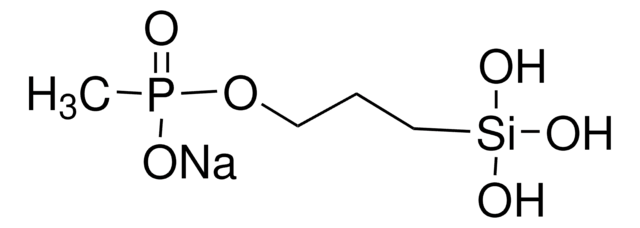Wichtige Dokumente
91957
Methylphosphonsäure Mononatriumsalz
99.0-101.0% (T)
Synonym(e):
Methanphosphonsäure Mononatriumsalz, Mononatriummethylphosphonat
About This Item
Empfohlene Produkte
Qualitätsniveau
Assay
99.0-101.0% (T)
Form
crystals
Konzentration
18.5-20.5% Na
Verlust
≤2.0% loss on drying
pH-Wert
4.5-5.1
Löslichkeit
water: 3.54 g/30 mL, colorless
Kationenspuren
Al: ≤5 mg/kg
Ba: ≤5 mg/kg
Bi: ≤5 mg/kg
Ca: ≤50 mg/kg
Cd: ≤5 mg/kg
Co: ≤5 mg/kg
Cr: ≤5 mg/kg
Cu: ≤5 mg/kg
Fe: ≤5 mg/kg
K: ≤50 mg/kg
Li: ≤5 mg/kg
Mg: ≤5 mg/kg
Mn: ≤5 mg/kg
Mo: ≤5 mg/kg
Ni: ≤5 mg/kg
Pb: ≤5 mg/kg
Sr: ≤5 mg/kg
Zn: ≤5 mg/kg
UV-Absorption
λ: 260 nm Amax: ≤0.2
λ: 280 nm Amax: ≤0.07
Eignung
no residue for filter test
SMILES String
O=P(C)(O[Na])O
InChI
1S/CH5O3P.Na/c1-5(2,3)4;/h1H3,(H2,2,3,4);/q;+1/p-1
InChIKey
CZVWTNTXBUVAFR-UHFFFAOYSA-M
Anwendung
Signalwort
Danger
H-Sätze
Gefahreneinstufungen
Acute Tox. 4 Oral - Eye Dam. 1 - Skin Corr. 1B
Lagerklassenschlüssel
8A - Combustible corrosive hazardous materials
WGK
WGK 3
Flammpunkt (°F)
Not applicable
Flammpunkt (°C)
Not applicable
Analysenzertifikate (COA)
Suchen Sie nach Analysenzertifikate (COA), indem Sie die Lot-/Chargennummer des Produkts eingeben. Lot- und Chargennummern sind auf dem Produktetikett hinter den Wörtern ‘Lot’ oder ‘Batch’ (Lot oder Charge) zu finden.
Besitzen Sie dieses Produkt bereits?
In der Dokumentenbibliothek finden Sie die Dokumentation zu den Produkten, die Sie kürzlich erworben haben.
Kunden haben sich ebenfalls angesehen
Unser Team von Wissenschaftlern verfügt über Erfahrung in allen Forschungsbereichen einschließlich Life Science, Materialwissenschaften, chemischer Synthese, Chromatographie, Analytik und vielen mehr..
Setzen Sie sich mit dem technischen Dienst in Verbindung.


